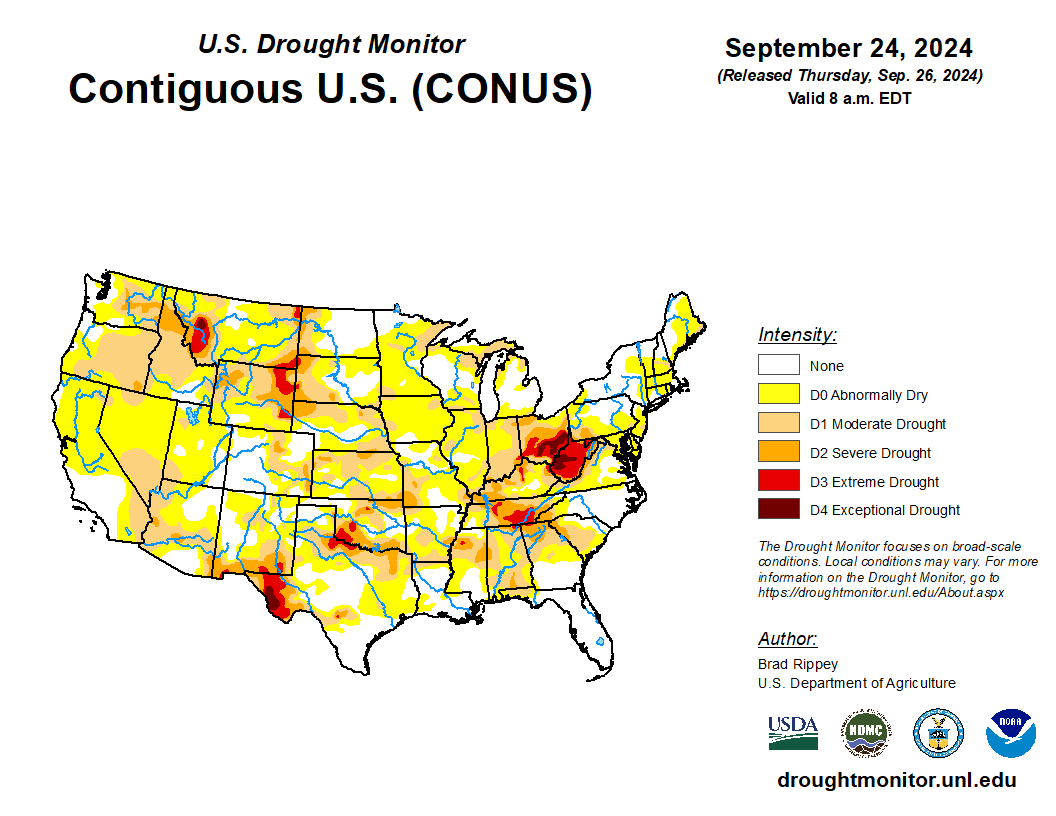U.S. Weather/Crop Progress


Highlights:
- 14% of the corn is now harvested, up 5 points from last week, 1 point ahead of last year and 3 points ahead of the 5-yr average. Sorghum harvest is at 29%, 2 points ahead of last year and the 5-year average. Barley harvest is now 97% completed, up 3 points from last week, 2 points ahead of last year and 1 point ahead of the 5-year average. Soybean harvest in now underway and 13% completed, 3 points ahead of last year and 5 points ahead of the 5-year average.
- The corn crop condition was unchanged this week with the Good/Excellent rating at 65%. Hot dry weather is pushing corn to dry down as harvest approaches. Sorghum condition held steady with the G/E category at 44%. 22% of sorghum is now rated poor to very poor condition due to excessive heat and dryness. The soybean condition rating held steady at 64% G/E.
- In the West, dry weather accompanies above-normal temperatures. The warmest weather, relative to normal, is occurring across the interior Northwest, where gusty winds are developing. A blowing dust advisory is in effect today for parts of eastern Washington, where today’s high temperatures could locally top 90°F.
- On the Plains, warm, dry weather is promoting summer crop maturation and harvesting, as well as winter wheat planting and emergence. Some of the warmest weather is occurring across the northern High Plains, where today’s high temperatures could approach or reach 95°F as far north as eastern Montana. Despite recent rain showers, some areas still lack sufficient topsoil moisture for the proper establishment of fall-sown grains.
- In the Corn Belt, lingering showers are confined to parts of the Ohio Valley and the lower Great Lakes region. Elsewhere in the Midwest, mild, dry weather favors a return to fieldwork, including early-season harvest activities. However, a few areas, mainly across Missouri and southern Illinois, received enough rain in recent days to keep fieldwork on hold.
- In the South, producers in Florida, Georgia, and portions of neighboring states are making final preparations in advance of Helene’s approach. With most Southeastern cotton bolls open and the peanut harvest only having just begun, there is significant crop vulnerability in areas forecast to receive drenching rains and high winds.
Outlook:
Tropical Storm Helene, soon expected to become a hurricane, is forecast to make landfall in Florida’s Big Bend late Thursday, with an intensity and path similar to that observed with Category 3 Hurricane Idalia, on August 30, 2023. Less than 2 months ago, Category 1 Hurricane Debby also moved ashore in the same general area of Florida. A storm surge of 10 to 15 feet is likely with Helene along and just to the east of where the center moves ashore, with a surge of at least 5 feet forecast along Florida’s west coast as far south as Tampa Bay. In addition, a significant inland push of hurricane-force winds (74 mph) is likely across north-central Florida and southwestern Florida, with likely impacts on timber, as well as crops such as cotton and pecans. Finally, Southeastern storm-total rainfall of 5 to 10 inches, with locally higher amounts, could lead to significant inland flooding, extending as far north as the southern Appalachians. Southeastern rainfall could linger for several days, as the remnants of Helene interact with a disturbance over the mid-South. Much of the remainder of the country will experience warm, dry weather, ideal for summer crop maturation and harvesting, as well as winter wheat planting. However, lack of soil moisture for the establishment of winter grains and cover crops will remain a concern in drought-affected areas. The NWS 6- to 10-day outlook for September 30 – October 4 calls for near- or above-normal temperatures nationwide, with the Southwest having the greatest likelihood of experiencing warm weather. Meanwhile, near- or below-normal precipitation across much of the country should contrast with wetter-than-normal weather in the southern and middle Atlantic States.

